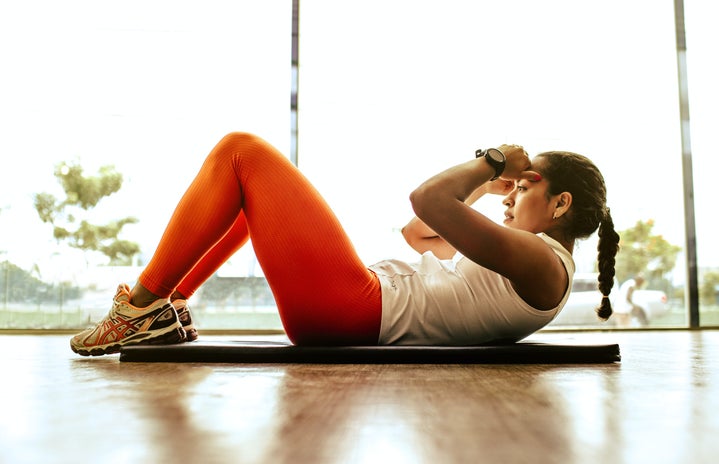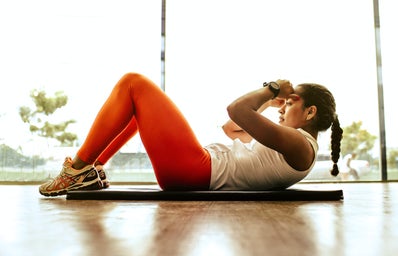Starting a yoga practice can be confusing for many reasons. Learning body awareness, balance, and building the strength and flexibility to get deeper into certain poses can prove to be challenging if you’re just starting to find a yoga home on your mat. And sometimes the most difficult thing about approaching yoga as a new, or even returning, student is just understanding what the teacher is saying. Half the time many teachers will queue poses in Sanskrit and then switch back to English, or certain instructors may queue transitions using specific verbiage. Depending on the type of class you’re going to, the varieties of wording may seem pretty foreign. Even as a seasoned practitioner, I find myself mindlessly hearing pose names and not paying attention to other words and important terms being said.
So, for my own vocab refresher and for those who find themselves a little lost when listening to yoga instructors teach, I’ve made a list of the top 15 most common yoga vocab words and their meanings.
1. Vinyasa
Vinyasa translates to “flow” and typically refers to a form of yoga in which movement is linked to breath to create a sequence of poses that flow together. Additionally, at some studios, the term “vinyasa” is used to describe the three linked poses of chaturanga, up-dog, and down-dog, done together at the end of a flow. For example, in a vinyasa class you may hear an instructor say, “Exhale to take your vinyasa,” meaning they are queueing students to take their chaturanga into up-dog, and then down dog.
2. Asana
This sanskrit term is a branch of yoga that literally translates into “seat,” but refers to any posture or pose in yoga. It can be applied in several ways to yoga verbiage, such as referring to a more rigorous class as having difficult physical asanas.
3. Ujjayi Breath
In most yoga classes, instructors will begin to queue poses to have students build heat while simultaneously starting ujjayi breath. This type of empowering breathing translates to “victorious breath,” and involves students only inhaling and exhaling through the nose. This breath with a slight constriction of the throat may also produce audible exhales, and provides an invigorating way for students to breathe deeply and eventually consciously link their breath to movement.
4. Chaturanga
Other than down dog, this pose is perhaps the most commonly used and frequently practiced throughout any vinyasa yoga class. It translates to “four limbed staff pose,” and involves lowering down on an exhale from high plank to a 90 degree angle in the elbows. It may sound similar to a push up, but chaturanga involves a specific alignment in which the elbows and triceps are hugged in right at your sides. Instead of pushing back up to plank like in a push up, typically students will then inhale to pull their chest through their shoulders from the bottom of their chaturanga into up dog, and then exhale into down dog. Chaturangas are not just used in vinyasas (chaturanga → up dog → down dog), though. In a more challenging vinyasa class, instructors may also queue a “chaturanga push up” into a flow, in which students will take their chaturanga and then push back up to plank to build heat.
5. Pranayama
This branch of yoga refers to breathing exercises that may be incorporated at different times in class to help students control the breath. Pranayama may also be used to guide students into meditation at the beginning or end of class. For example, an instructor may introduce pranayama such as having students breathe in through their right nostril while covering their left, and then breathing oppositely while sitting in seated meditation. Pranayama allows students to reconnect with their breath and provides a meditative way to practice mindfulness.
6. Bandhas (ex: uddiyana bandha, mula bandha)
The bandhas are the various physical locks throughout your body that can be accessed and targeted through specific muscle contractions and tightening. Uddiyana bandha, for example, refers to the space below your belly button, or your lower “core.” When an instructor queues students to “engage uddiyana bandha” while in high plank, they are instructing students to tighten their core and pull in the floating ribs. Another common bandha referred to in class is your mula bandha, which refers to the pelvic floor. Instructors may ask students to “engage mula bandha and tilt the pelvis in” in chair pose to protect the low back and bring the strength into your quads instead.
7. Drishti
Drishti translates to “gaze” and can symbolize drawing the attention inward, or it can literally be used to instruct students to focus their gaze somewhere specific to deepen a pose. An instructor may say to “shift your drishti inward,” signifying bringing yourself back to your mat and focusing in on the breath without distractions bringing you away. In referring to the physical drishti, in aligning half moon pose, for example, the instructor may say, “Shift your drishti up to challenge your balance.”
8. Surya Namaskar (or Sun) A, B, C
Surya Namaskar translates to “sun salutations,” hence why many instructors will section class into “Sun As” or “Sun Bs”. These sequences are designed to build heat and parallel the style of vinyasa yoga, linking breath to movement throughout class. 5 rounds of Sun As start off the multiple flows of a vinyasa class and are typically super simple, involving side bends and a heart opener with a vinyasa in between each round to start to warm up the body. 5 rounds of Sun Bs follow, and these sequences vary based on instructor, studio, and style of vinyasa. Traditionally, in between each “round” — meaning a full sequence of poses completed on the left and right legs — students return to the top of the mat and hold chair pose. Sun Cs are even more unique to the studio and instructor, and a third flow may not even exist in some vinyasa classes.
9. Namaste
The term “namaste” has been increasingly westernized, as many people use it as a gimmick on tshirts (ex: “nama-stay in bed), in memes, or as a way to seem “zen.” However, traditionally, namaste means “I bow to you” and is said as a sign of respect. At the end of every yoga class, the instructor says namaste as an acknowledgment and reciprocation of others and their light. Students repeat it back to symbolize that mutual respect and appreciation.
10. Sacrum
Your sacrum is a triangular shaped bone at the base of the spine. If you have back dimples, your sacrum is the bone that rests in between them at the middle of your lower back. Instructors will make physical adjustments such as tilting the pelvis and making sure students are hinging/folding from the hips instead of hunching to help students protect the sacrum and avoid lower back pain. For example, while holding students in goddess squat, an instructor may queue them to first put one hand on the lower belly, one on the sacrum, and then manually tilt their pelvis in to safely deepen the pose. A similar adjustment may also be made in chair pose, as dumping into the low back/sacrum over time may cause compression pain.
11. Savasana
Savasana can be translated into “corpse pose.” It also refers to the restorative portion of class known as “final rest.” This is the last few minutes of class in which students are guided into a meditation to end class and close their practice. Instructors will typically lead into savasana by tying back in their theme for the class, perhaps reminding students to thank their bodies for the work it’s done and that they deserve rest. Depending on the instructor, students may take their final rest on the back, in a seated meditation, child’s pose, on the belly, or even somewhere in stillness with the support of a block.
12. Sitz Bones
These are the protruding, almost knobby bones that stick out under the flesh of your butt when you sit. When we sit with “bad” posture, or slumped over with a rounded back, we sit with our sitz bones tucked under us. In a yoga class, many instructors will queue students to pull the flesh away out and away from their butt when seated so that they’re sitting directly on their sitz bones. This helps lengthen the spine and promote good posture, and it also helps students more easily hinge at the hips for more length in seated forward fold and a pancake fold (in which you sit with your legs out wide in a seated split and lean forward down the middle of your legs). For example, you may hear an instructor queue, “root down through the sitz bones in your seated meditation.”
13. Yin/Yang Poses
Yin and Yang represent opposite forces in many contexts, and the same goes for yoga. Yin symbolizes more passive, cooling, downward motion. Yang, on the other hand, is dynamic, warming, and upward moving. In the case of different types of yoga poses, yin refers to the final closing, restorative poses of class that serve to cool the body down and gently stretch and replenish muscles and limbs. Yang poses, on the other hand, are more fiery and active. There are also both yang and yin versions of poses. For example, at the end of class an instructor may have students take a yang variation of a paschimottanasana, or seated forward fold, by taking a bind and actively pulling themselves deeper. Then, the instructor may have students release their bind in the fold and transition into a yin version of paschimottanasana, passively slumping over the legs and letting go of any tension.
14. Inversion
An inversion refers to any pose where the head is below the heart, or in other worlds, “upside down” poses. Instructors typically allot a specific portion of class for students to take their favorite inversion and hold it for a certain number of breaths. Inversions promote a certain concentration and mindfulness that is not only physically strengthening, but also mentally challenging. Common ones include down dog, shoulder stand, headstand, candlestick, and dolphin pose. Yogis with a more advanced inversion practice may opt to take on pincha mayurasana, or forearm stand, handstand, tripod headstand, and crow pose.
15. Utkatasana
Utkatasana is the sanskrit name for Chair Pose. This pose is one of the most common poses of several types of yoga, including Vinyasa and Ashtanga. As discussed above, Utkatasana is the grounding pose where students return between each round of Sun Bs, and can be integrated into flows as well. If you’ve been to a vinyasa yoga class, chances are you’ve heard the instructor command, “We’ll meet at the top of the mat in Utkatasana to start our next flow!”



